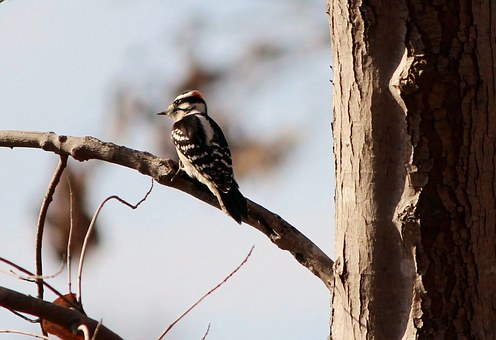Offer
Provide additional details about the offer you're running.
Provide additional details about the offer you're running.
Provide additional details about the offer you're running.

Most birders can easily identify that a particular bird is indeed a woodpecker, but most experience trouble when trying to identify the specific species of woodpeckers commonly seen in their backyards.
This quick guide will go over six popular species of woodpeckers and serve as an identification aid, but we always recommend having your trusted Field Guide in hand for quick reference.
Downy Woodpecker
One of the smallest species of woodpeckers in Canada, the Downy sports a black and white plumage with a broad white stripe down its back. The wings display a checkered pattern, while the crown of the head is black with both black and white lines along the cheeks and neck of the bird.
The male and female Downies are roughly the same size, but you can spot a male by the patch of red feathers at the back of the crown.

Red-Headed Woodpecker
The red-headed woodpecker adults have a black back and tail, with you guess it: a red head and neck. The underparts of this bird are mainly white, with black wings adorned with white secondaries. The red-headed woodpecker is a medium-sized woodpecker, and interestingly, is one of only four North American Woodpeckers known to store food.

Red-Bellied Woodpecker
Not to be confused (but often are) with the red-headed woodpecker, the red-bellied woodpecker is a much more pale looking woodpecker. Adults are mainly light grey on their face and under parts, with black and white barred patterns on their back, tail and wings. They do also obviously have a red belly, but it is usually quite difficult to view on the bird in the wild.
Adult males sport a red cap going from the bill to the nape, while females have a red patch on the nape and another above their bill.

Pileated Woodpecker
With its striking size, the Pileated Woodpecker is often a wonderful sight to birders. Adults are mainly black with a red crest and white line down the sides of their throats. Male Pileated Woodpeckers have a red line from the bill to the throat and red on the front of the crown. While in females, these lines are black.
As stated, the Pileated is a very large woodpecker with a long neck, often roughly the size of a large crow. As a point of interest to birders, the Pileated Woodpecker is a bug eater, equipped with a very long tongue that actually separates inside of their skull and wraps in around behind the head! These vocal birds often travel in pairs, and a large suit feeder is your best bet to bringing them into close range.

Hairy Woodpecker
Bearing a heavy resemblance to the much smaller Downy Woodpecker, the Hairy Woodpecker adults are mainly black on their upper parts and wings. They also have a white or pale black and white spotting on their wings, and depending on the subspecies, their throat and bellies can vary from a white color to a sooty brown coloring.
The Hairy Woodpecker also have a distinctive white bar above and below the eye, while males can be seen with a red patch on the back of their heads, seen as more of an orange-red color among juveniles.
As far as distinguishing the Hairy Woodpecker from the Downy Woodpecker, you must look beyond the basic plumage. The Downy has a shorter bill in comparison to the size of its head and has additional spotting on its white tail feathers, which the Hairy Woodpecker does not.
Yellow Bellied Sap Sucker

A medium-sized woodpecker, the Yellow Bellied Sap Sucker adults are black on the back and wings, both adorned with white bars. Their heads are also black sporting white lines down both the sides and forehead and crown of the bird. The Yellow Bellied Sap Sucker, as its name suggests, also has a yellow breast and upper belly with a white lower belly and rump with a black tail with a white bar down the center. Deciphering males and females are relatively easy, the males have a red throat while females throats are white in color.
High Quality Blend
